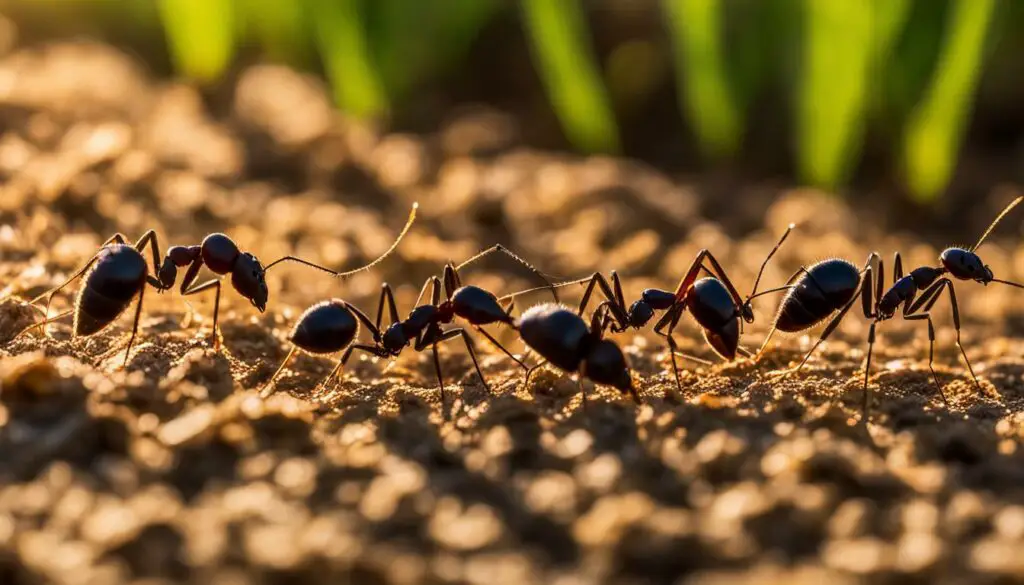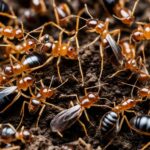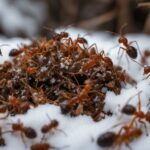Greetings, fellow nature enthusiasts! Today, I’m excited to delve into the fascinating world of harvester ants and their distinctive feeding habits. These incredible creatures have captured the attention of scientists and nature lovers alike with their intriguing foraging patterns and food preferences. Join me as we explore the diet and feeding behavior of these industrious ants and unravel the mysteries of their nutrition and colony food sources.
Harvester ants, particularly the red harvester ant (Pogonomyrmex barbatus), are often mistaken for fire ants, but they are actually a unique species with their own distinct characteristics. Ranging from red to dark brown and measuring between 1/4 to 1/2-inch in length, these ants are known for their ability to hoard seeds in large quantities. Their powerful sting and nocturnal nest sealing behavior make them a force to be reckoned with in the southwestern United States.
Key Takeaways:
- Harvester ants, like the red harvester ant, have a unique diet primarily consisting of seeds.
- These ants exhibit foraging patterns, with patrollers locating food sources and leaving chemical trails for the foragers to follow.
- Harvester ants are not related to fire ants and are common in the southwest United States.
- Understanding the feeding habits of harvester ants is crucial for their conservation and the preservation of their habitats.
- Stay tuned as we dive deeper into the fascinating world of harvester ants and uncover their secrets!
A Fascinating Society and Foraging Behavior
Harvester ants have a unique and fascinating society, with a complex social structure that enables efficient foraging and nest maintenance. The colony consists of a queen, winged males, female swarmers, and sterile female workers. The queen is responsible for producing workers and alates, which are fertile males and females that leave the colony to reproduce. The workers perform various tasks within the colony, including nest maintenance, foraging, and patrolling.
The foraging behavior of harvester ants is particularly intriguing. Patrollers, which are specialized worker ants, venture out in the morning to locate food sources. Once a patroller finds a food source, it leaves a chemical trail for the foragers to follow. The foragers then gather the food and bring it back to the colony. This division of labor within the colony ensures an efficient and coordinated effort in procuring food.
Harvester ants primarily feed on seeds, but they may also consume other small insects and arthropods. Their diet is influenced by the availability of food sources in their habitat. The seeds harvested by the ants not only serve as a source of nutrition for the colony but also contribute to seed dispersal in their environment. This makes them an important component of the ecosystem.
Impressive Nest Sealing and Mating Behaviors
Another intriguing aspect of harvester ant behavior is their nest sealing and mating behaviors. Harvester ants are known to seal their nest entrances at night using small pebbles, sand, or dirt. This behavior helps protect the colony from potential threats and intruders during their inactive period.
Mating in harvester ants occurs through swarming. The queen produces alates, which are winged ants, to leave the colony and mate with alates from other colonies. These mating flights usually occur in late summer or early autumn when environmental conditions are suitable. By establishing new colonies through mating, harvester ants ensure the survival and expansion of their species.
The society and foraging behavior of harvester ants are captivating to observe and study. Their division of labor, unique foraging strategies, nest sealing, and mating behaviors provide valuable insights into the complexity and efficiency of ant colonies.
Identifying Harvester Ants and Their Nests
When it comes to identifying harvester ants, there are a few key characteristics to look out for. These ants can be recognized by their red, black, or brown coloration, and their heads feature a distinct fringe of hairs known as psammaphore. Their bodies are typically between 1/4 to 1/2-inch in length, and they can be found in the southwest United States.
Harvester ant nests are another important feature to identify. These nests are commonly found in open areas such as plains, and they are characterized by the presence of a distinct mound. The mound is often surrounded by stripped vegetation and may be covered with small pebbles. Inside the nest, there are tunnels, chambers, and a sorting chamber where foragers drop their gathered items.
Here is a complete table summarizing the identifying features of harvester ants and their nests:
| Identifying Feature | Description |
|---|---|
| Color | Red, black, or brown |
| Psammaphore | Fringe of hairs lining the underside of the head |
| Nest | Mound with a single opening, surrounded by stripped vegetation, and covered with small pebbles |
| Internal Structure | Tunnels, chambers, and sorting chamber for forager drop-offs |
By understanding these identifying features, you’ll be able to confidently recognize harvester ants and their nests.
Understanding the Diet of Harvester Ants
Harvester ants have a diverse diet that primarily consists of seeds, with certain preferences for specific types. These ants are particularly fond of grass seeds, especially those from the Needle Grama grass. However, they are not limited to grass seeds alone. Harvester ants also consume seeds from a variety of other plants, including pine, ragweed, pokeweed, and bluebonnets. Their ability to consume a wide range of seeds allows them to adapt to different environments and food sources. Additionally, harvester ants may also consume other small insects, arthropods, and even animal feces.
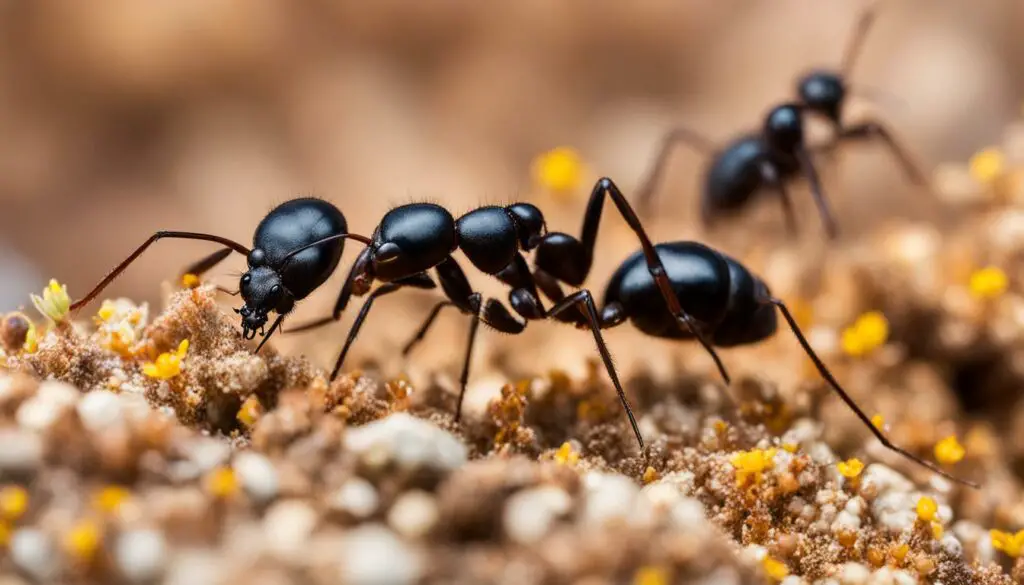
Harvester ants’ feeding habits are influenced by their unique foraging behavior. In the morning, patrollers locate food sources and leave chemical trails for the foragers to follow. This communication system ensures efficient exploitation of available resources. The patrollers play a crucial role in finding and marking food sources, while the foragers rely on these trails to locate and collect the food. This division of labor within the colony optimizes their foraging efficiency and allows them to gather a sufficient supply of seeds to sustain the colony.
To further understand the diet of harvester ants, it is important to study their seed preferences and how they contribute to the dispersal of seeds. By consuming a variety of seeds, harvester ants aid in the dispersal of plants, contributing to the distribution and diversity of flora in their habitat. They play a significant role in the ecosystem by promoting the growth and survival of different plant species. Additionally, their consumption of small insects and arthropods helps maintain the balance of these populations within their environment.
The Life Cycle and Reproduction of Harvester Ants
Harvester ants have a fascinating life cycle that includes various stages of development and reproduction. Understanding the life cycle of these ants can provide valuable insights into their behavior and contribute to their conservation. Let’s explore the different phases of their life cycle.
Queen Lifespan and Reproduction
At the heart of every harvester ant colony is the queen. The queen is responsible for producing new generations of ants and maintaining the population of the colony. The lifespan of a harvester ant queen can range from 15 to 20 years. During her lifetime, the queen continuously lays eggs, ensuring the growth and survival of the colony.
When the colony reaches five years of age, the queen also produces alates. Alates are winged males and females that leave the colony to mate with alates from other colonies. This process helps in the establishment of new colonies and ensures genetic diversity among harvester ant populations.
Development and Emergence of Workers
Once the queen lays eggs, they undergo a process of development. The eggs hatch into larvae, which are cared for by the worker ants. The worker ants feed and groom the larvae, ensuring their healthy growth. After the larvae undergo metamorphosis, they emerge as adult worker ants.
The worker ants are responsible for various tasks within the colony, such as foraging for food, maintaining the nest, and taking care of the queen and her offspring. They work together in a highly organized manner to ensure the survival and success of the colony.
| Life Cycle Stage | Description |
|---|---|
| Egg | The initial stage of development, where the queen lays eggs. |
| Larva | The second stage, where the larvae are cared for by the worker ants and undergo growth and development. |
| Pupa | The third stage, where the larvae undergo metamorphosis and transform into adult ants. |
| Adult | The final stage, where the ants emerge as adults and perform various tasks within the colony. |
The life cycle of harvester ants is a remarkable process that highlights the complexity and resilience of these insect societies. By studying and understanding their life cycle, we can gain a deeper appreciation for the fascinating world of harvester ants and work towards their conservation and protection.
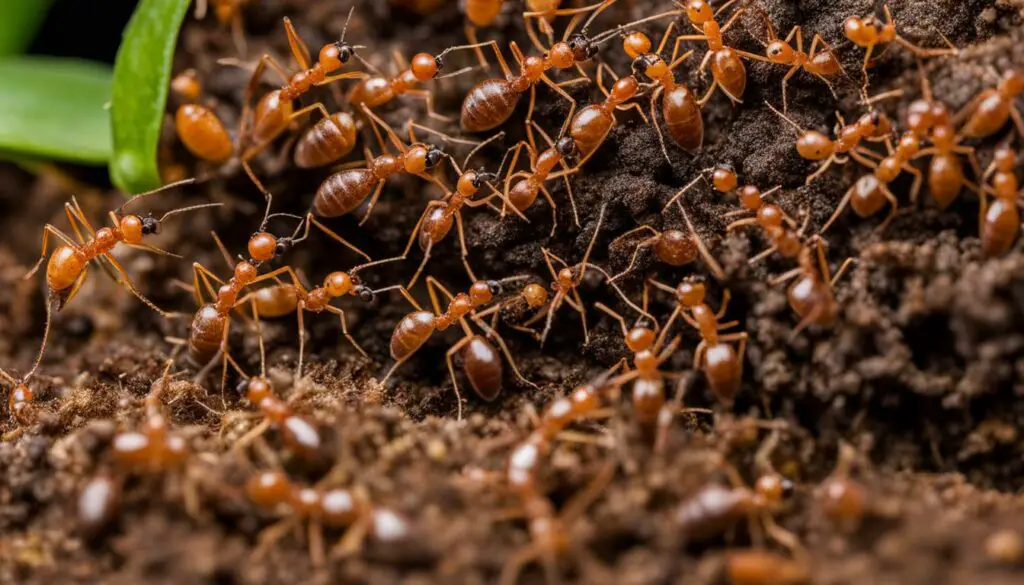
“The life cycle of harvester ants showcases the intricate processes of reproduction and development within their colonies.”
Preventing and Managing Harvester Ant Infestations
When it comes to dealing with harvester ant infestations, prevention is key. By taking proactive measures, you can minimize their presence and reduce the risk of encounters with these stinging insects. One effective approach is selective treatment of exterior sites with insecticide. This targeted application can help control harvester ants without harming other beneficial insects.
Another important step in preventing harvester ant infestations is sealing cracks and crevices around your property. Harvester ants are known to exploit even the smallest openings, so it’s crucial to close off potential entry points. By blocking their pathways, you can keep these ants from establishing colonies near your home or garden.
In cases where harvester ant infestations have already occurred, professional pest control services can be your best ally. These experts have the knowledge and tools to effectively manage infestations, especially considering the potentially large colony size and stinging capabilities of harvester ants. They can assess the extent of the infestation, implement targeted treatment plans, and provide ongoing monitoring to ensure long-term control.
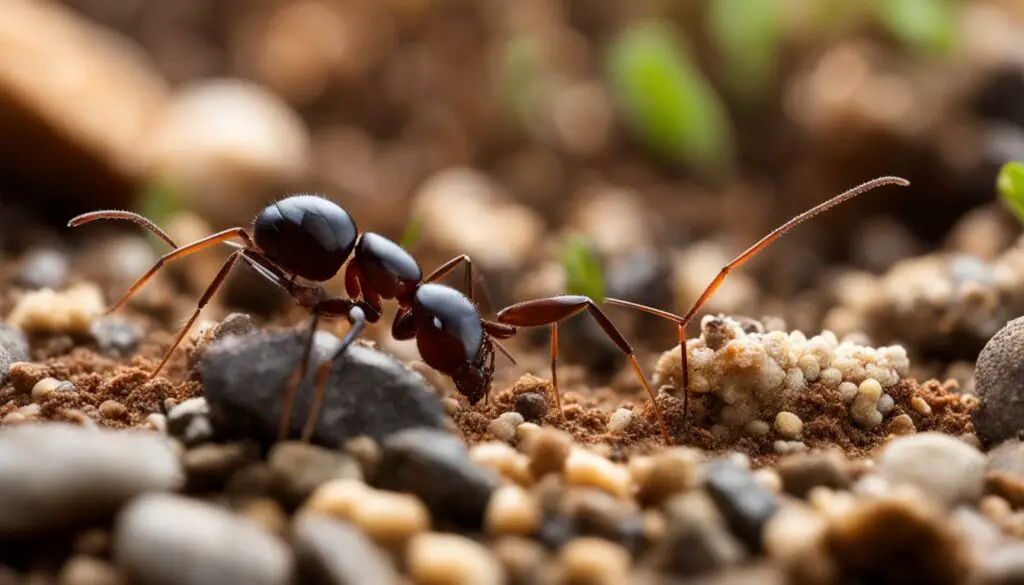
Harvester Ant Infestation Management
Effective harvester ant infestation management involves a multi-faceted approach. It’s important to address not only the immediate infestation but also the underlying factors that attract these ants to your property. By implementing integrated pest management strategies, you can achieve long-term control and minimize potential re-infestations.
- Identification and Inspection: Properly identify harvester ants and locate their nests to determine the extent of the infestation.
- Sanitation: Remove potential food and water sources that may be attracting harvester ants.
- Exclusion: Seal all cracks, crevices, and openings to prevent ant entry into your home or building.
- Chemical Control: Use targeted insecticides in a safe and effective manner to eliminate existing ant colonies.
- Monitoring: Regularly monitor your property for signs of ant activity and take immediate action if infestations return.
By following these best practices for preventing and managing harvester ant infestations, you can protect your home, property, and family from these potentially harmful insects.
The Impact of Harvester Ants on the Environment
Harvester ants can have significant effects on the environment due to their nesting habits and foraging behavior. These ants, known for their seed-hoarding behavior, often clear vegetation around their nests, resulting in bare ground. This can lead to increased soil erosion, as the lack of vegetation exposes the soil to wind and water erosion. The removal of vegetation also disrupts the natural balance of the ecosystem and can impact the diversity and abundance of plant species in the area.
Furthermore, harvester ants can cause damage to crops through their foraging activities. As they primarily feed on seeds, they have been known to consume seeds of agricultural crops, leading to reduced crop yields. The extent of the damage depends on the proximity of the ant colonies to the agricultural fields and the availability of alternative food sources. In some cases, farmers may need to implement measures to mitigate the impact of harvester ants on their crops, such as the use of insecticides or physical barriers.
In addition to soil erosion and crop damage, harvester ants can also cause road damage. Their large nests can be found near roadways, and the ants’ digging activities can weaken the soil beneath the pavement, leading to potholes and structural damage. This can be a safety hazard for motorists and may require road maintenance and repair to ensure the safety and integrity of the roads.
| Impact of Harvester Ants | Description |
|---|---|
| Soil Erosion | Harvester ants clear vegetation around their nests, contributing to increased soil erosion. |
| Crop Damage | Harvester ants may consume seeds of agricultural crops, leading to reduced crop yields. |
| Road Damage | Harvester ants’ nesting activities near roadways can cause potholes and structural damage to the pavement. |
It is important to consider the ecological impact of harvester ants and develop strategies to mitigate their negative effects. Conservation efforts that focus on preserving natural habitats and promoting biodiversity can help maintain a balanced ecosystem. Furthermore, implementing sustainable farming practices and exploring alternative pest control methods can help reduce the crop damage caused by harvester ants. By understanding and addressing the impact of harvester ants on the environment, we can work towards creating a harmonious coexistence between humans and these fascinating insects.
Understanding Harvester Ant Behavior and Habits
Harvester ants are fascinating creatures with unique behavior and habits. Their stinging capabilities, diurnal foraging patterns, and nest maintenance activities make them intriguing subjects of study. Let’s explore some of the key aspects of harvester ant behavior.
Foraging and Nest Maintenance
Harvester ants are diurnal insects, meaning they are active during the day and rest at night. They have a well-defined foraging behavior, with patrollers locating food sources in the morning and leaving chemical trails for other ants in the colony to follow. This efficient system ensures a steady supply of food for the colony. In addition to foraging, harvester ants also engage in nest maintenance activities such as repairing and sealing their nest entrances. This helps protect the colony from intruders and maintains a stable environment for the ants to thrive.
Stinging Capabilities
One notable aspect of harvester ants is their stinging capabilities. When threatened or disturbed, harvester ants can deliver a painful sting that can cause discomfort and potential allergic reactions in humans and animals. It is important to exercise caution and avoid provoking these ants to prevent any unnecessary stings. If stung, proper first aid should be administered to alleviate the pain and swelling.
Midden Area and Unwanted Items
Harvester ants have a designated area within their nest called the midden, where they deposit unwanted items such as debris, dead insects, and discarded nest materials. This area serves as a waste collection site, ensuring cleanliness and hygiene within the colony. The midden area provides valuable insights into the behavior and habits of harvester ants, highlighting their commitment to maintaining a well-organized living space.
Understanding the behavior and habits of harvester ants is crucial for researchers, pest control professionals, and individuals interested in these fascinating insects. By studying their foraging patterns, nest maintenance activities, and stinging capabilities, we can gain a deeper appreciation for the intricate world of harvester ants.
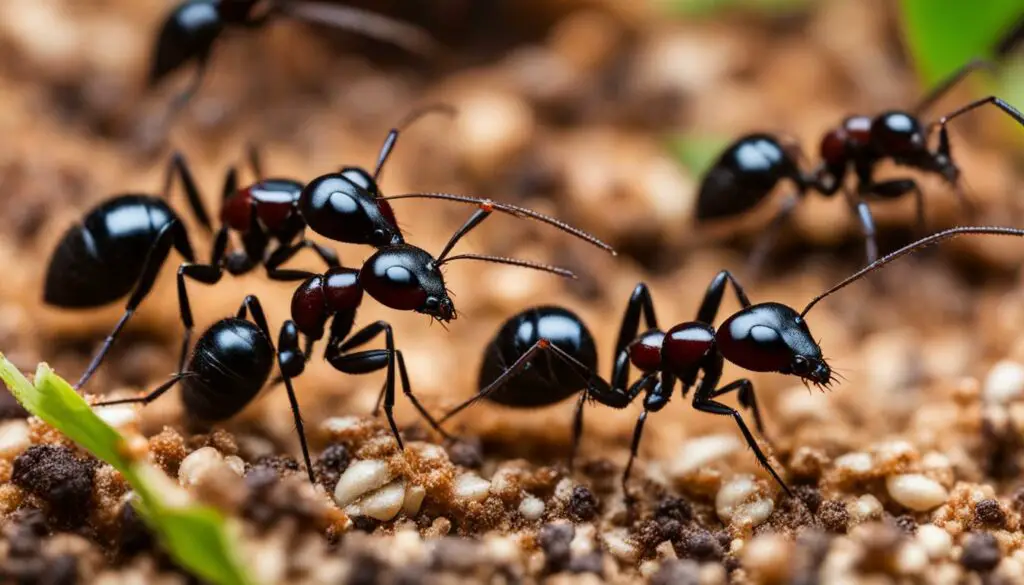
The Role of Harvester Ant Queens in Colony Survival
Harvester ant queens play a crucial role in the survival and growth of the colony. As the only individuals capable of reproducing, they are responsible for producing both the sterile female workers and the winged alates that will leave the nest to establish new colonies. The queen’s lifespan can extend up to 15-20 years, allowing her to continuously lay eggs throughout the colony’s existence. Without a viable queen, the colony will eventually perish as she is not replaced.
Table:
| Queen Role | Queen Lifespan | Queen Reproduction |
|---|---|---|
| Produce workers and alates | 15-20 years | Lay eggs continuously |
The alates produced by the queen serve a vital purpose in maintaining and expanding the colony. They are winged ants that leave the nest in large swarms to mate with alates from other colonies. Once mated, the females become fertilized and have the potential to establish new colonies. This process ensures the survival and genetic diversity of harvester ant populations.
It is important to note that the reproductive success of the queen is influenced by various factors, including environmental conditions and the availability of resources. A healthy and productive queen is essential for the long-term survival and growth of harvester ant colonies.
Dealing with Harvester Ant Stings
While harvester ants are fascinating creatures, their stings can be painful and potentially cause allergic reactions in some individuals. If you find yourself stung by a harvester ant, it’s important to take immediate action to alleviate the discomfort and minimize the risk of complications.
To treat a harvester ant sting, start by cleaning the affected area with soap and water to prevent infection. Applying ice or a cold compress can help reduce swelling and provide some relief. Over-the-counter pain medication, such as acetaminophen or ibuprofen, can be taken to manage any pain or discomfort caused by the sting.
In more severe cases, where the individual experiences an allergic reaction to the harvester ant venom, it is crucial to seek medical attention promptly. Anaphylaxis, characterized by symptoms such as difficulty breathing, swelling of the face or throat, and a rapid heartbeat, requires immediate medical intervention. Individuals with known allergies to ant stings should always have an epinephrine auto-injector (EpiPen) on hand.
Remember that prevention is key when it comes to harvester ants. To reduce the likelihood of being stung, avoid provoking the ants or disturbing their nests. Wear protective clothing, such as long sleeves and pants, when spending time outdoors in areas known to have harvester ants. If you suspect an infestation near your property, it is advisable to consult a professional pest control service for effective management.
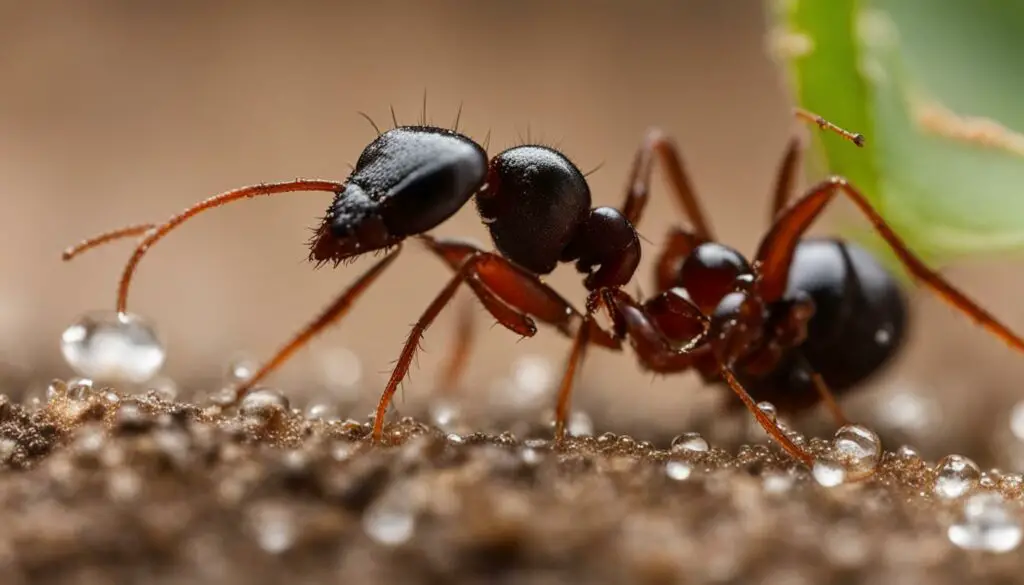
Table: Common Symptoms of Harvester Ant Stings
| Symptoms | Description |
|---|---|
| Localized pain and redness | Immediate pain and swelling at the site of the sting |
| Itching or irritation | Accompanying discomfort and urge to scratch the area |
| Swelling | Enlargement of the sting site, often extending beyond the immediate area |
| Allergic reactions | Difficulty breathing, swelling of the face or throat, rapid heartbeat |
By taking appropriate precautions and knowing how to respond to harvester ant stings, you can enjoy the beauty of these creatures while minimizing the risks associated with their stings. Stay safe and informed to make your encounters with harvester ants a positive and educational experience.
The Ecological Importance of Harvester Ants
Harvester ants play a crucial role in the ecological balance of their habitats. One of their key contributions is seed dispersal. These ants gather and hoard seeds, which helps to distribute plants throughout their environment. As they forage for seeds, they unintentionally carry them to new locations, allowing for the establishment and growth of plant populations in different areas. This process promotes biodiversity and helps to maintain healthy ecosystems.
In addition to seed dispersal, harvester ants also play a role in nutrient recycling. These industrious insects consume not only plant matter but also small insects and arthropods. By consuming and breaking down organic material, they contribute to the decomposition process and release nutrients back into the soil. This recycling of nutrients enriches the soil and supports the growth of plants, creating a sustainable cycle within the ecosystem.
Table: Comparison of Harvester Ants and Other Seed Dispersers
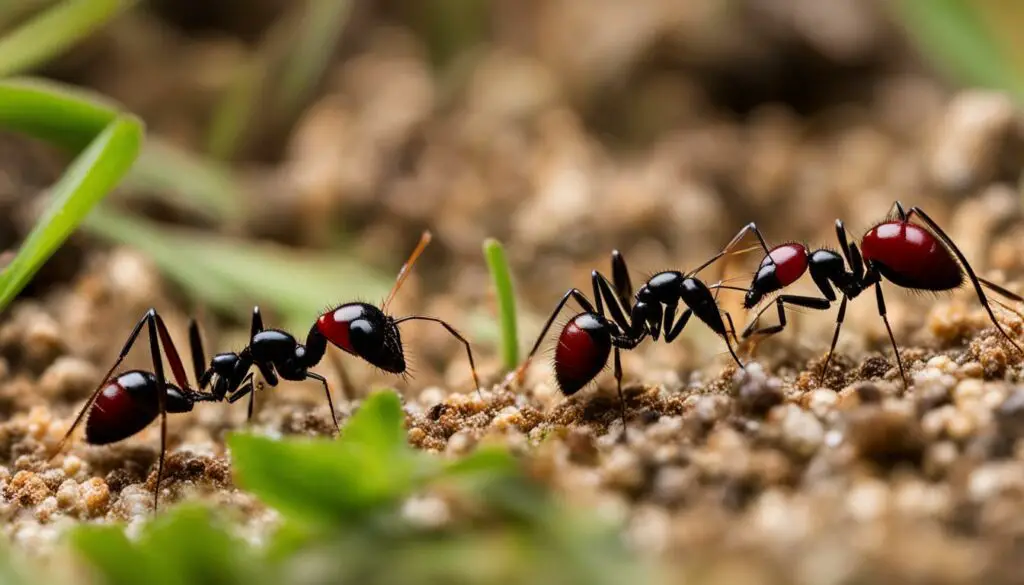
| Species | Seed Dispersal Mechanism | Range of Dispersed Seeds |
|---|---|---|
| Harvester Ants | Seed hoarding and unintentional dispersal during foraging | Various types of seeds from grasses and other plants |
| Birds | Seed ingestion and excretion | Small to medium-sized seeds |
| Wind | Seed dispersal through air currents | Seeds with specialized structures for wind dispersal |
| Water | Seed dispersal via water bodies | Seeds adapted for floating or water transport |
Understanding the ecological importance of harvester ants highlights their role as key players in maintaining the health and balance of their habitats. Protecting and preserving these ants and their environments is crucial for the overall well-being of the ecosystems they inhabit.
The Future of Harvester Ants
When it comes to the future of harvester ants, conservation efforts and the preservation of their habitats are crucial. While current populations of harvester ants, particularly the red harvester ant, are not endangered, there are potential threats that could impact their populations in the future. Habitat loss and the invasion of fire ants are among the factors that could disrupt their ecosystem and population dynamics.
Preserving the habitats in which harvester ants thrive is essential for their continued survival. This can be achieved through land management practices that prioritize the protection of open areas and plains where these ants typically build their nests. Conservation organizations and researchers play a vital role in studying and understanding harvester ants’ behavior, ecology, and population trends. By gathering valuable data and insights, they are able to craft effective conservation strategies and ensure the long-term viability of these fascinating insects.
Conservation Efforts and their Impact
Conservation efforts for harvester ants have been focused on raising awareness about their ecological importance and advocating for their protection. These efforts involve educating the public about the vital role harvester ants play in seed dispersal and nutrient recycling within their ecosystems. Additionally, organizations work to preserve their habitats by promoting sustainable land management practices and minimizing threats such as indiscriminate pesticide use.
Monitoring population trends is another crucial aspect of harvester ant conservation. By tracking the number of colonies and monitoring changes in their distribution, researchers can identify potential declines or shifts in population dynamics. This information helps guide conservation efforts and allows for targeted interventions to protect harvester ants and their habitats.
| Conservation Efforts | Impact |
|---|---|
| Education and awareness campaigns | Increasing public understanding of harvester ants’ ecological importance and the need for their conservation |
| Advocacy for sustainable land management practices | Preserving and protecting harvester ant habitats through responsible land management |
| Population monitoring and research | Identifying population trends and guiding targeted conservation actions |
It is crucial to prioritize the conservation of harvester ants to ensure the preservation of their unique feeding habits, complex social structure, and ecological significance. By understanding the population trends and implementing effective conservation strategies, we can contribute to the long-term survival of these remarkable creatures.
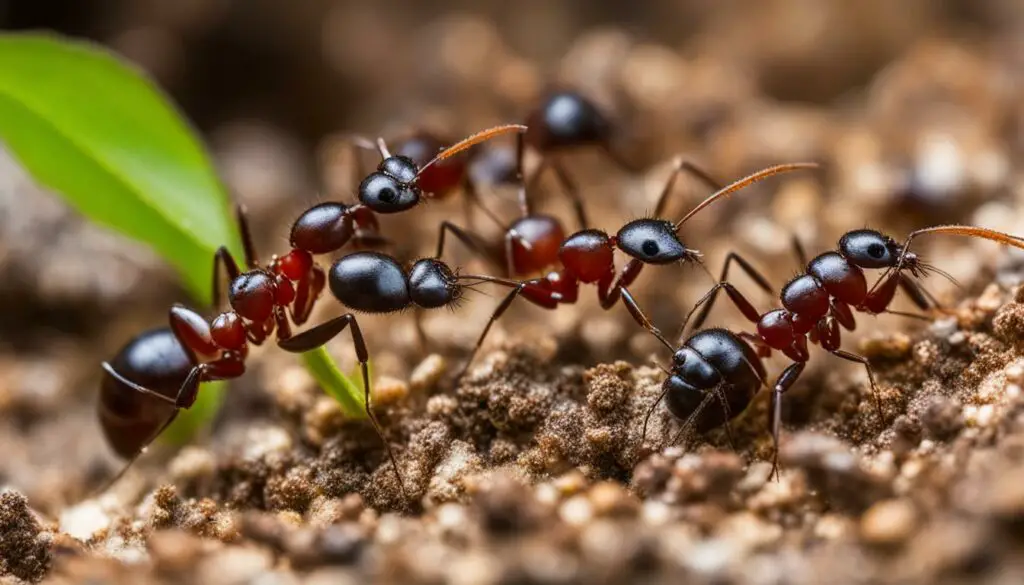
The Role of Harvester Ants in Ecotourism and Education
Harvester ants, particularly the red harvester ant, have become fascinating subjects of study and observation in the field of ecotourism and education. These remarkable insects with their unique feeding habits and social behavior offer valuable insights into the ecology of ant communities and their role in ecosystems.
Organizations and institutions have recognized the educational value of harvester ants, and they are often featured in insect zoos and educational programs. Their complex societies and intricate foraging patterns provide an excellent opportunity for students and enthusiasts to learn about ant behavior and the interconnectedness of species within their environment. Witnessing firsthand the diligent patrolling, food hoarding, and nest maintenance activities of harvester ants can inspire a sense of wonder and curiosity about the natural world.
Moreover, harvester ants have also contributed to the growth of ecotourism. Tourists and nature enthusiasts are drawn to areas where harvester ant colonies can be observed in their natural habitats. Guided tours and interpretive programs offer visitors a chance to explore the fascinating lives of these ants, witnessing their foraging expeditions and gaining a deeper understanding of the delicate balance of ecosystems. The presence of harvester ants in these ecotourism destinations serves as a reminder of the intricate webs of life that exist all around us.
Table: Comparison of Harvester Ants and Education Programs
| Category | Harvester Ants | Education Programs |
|---|---|---|
| Focus | Study of ant behavior and ecology | Experiential learning, environmental awareness |
| Engagement | Observation, hands-on activities | Interactive sessions, outdoor experiences |
| Benefits | Insights into ant communities, fostering curiosity | Environmental stewardship, connection to nature |
| Impact | Increased understanding of ecosystems | Inspiration for conservation efforts |
“Harvester ants provide a captivating way to engage individuals in the wonders of nature. Through educational programs and ecotourism initiatives, we can cultivate a greater appreciation for these remarkable creatures and foster a sense of responsibility towards the preservation of their habitats.” – Dr. Emily Thompson, Entomologist
By leveraging the captivating nature of harvester ants, both in educational programs and ecotourism initiatives, we can create a deeper connection between people and the natural world. The study of these ants not only offers valuable scientific insights but also enhances our understanding of the intricate relationships that shape our ecosystems. Through continued research, advocacy, and conservation efforts, we can ensure that future generations have the opportunity to appreciate and learn from the remarkable role that harvester ants play in both ecotourism and education.
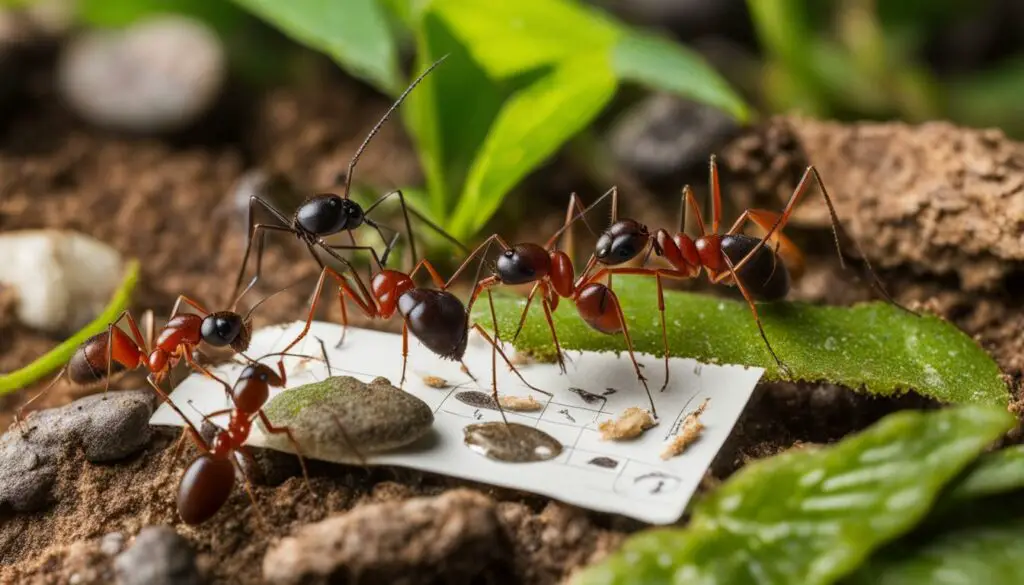
Potential Benefits and Risks of Keeping Harvester Ants as Pets
Keeping harvester ants as pets can be a fascinating and educational experience. These unique creatures have intriguing feeding habits and display complex social behavior within their colonies. However, it is important to consider the potential benefits and risks before deciding to keep harvester ants as pets.
Benefits of keeping harvester ants:
- Education and observation: Keeping harvester ants allows for a firsthand look at their daily activities, including foraging, nest maintenance, and communication. This can be a valuable educational experience, especially for children, as it promotes an understanding of ecosystems and the role ants play within them.
- Fascinating behavior: Harvester ants have a highly organized social structure that can be observed in captivity. Watching them work together and perform their specialized roles can be both entertaining and intriguing.
- Low maintenance: Compared to other pets, harvester ants require minimal care. Once their habitat is set up properly, they can thrive with little human intervention.
Risks of keeping harvester ants:
- Potential stings: Harvester ants are known for their stinging capabilities, which can cause pain and potential allergic reactions in humans and animals. It is crucial to handle them with caution and follow proper safety measures.
- Escape risk: Harvester ants are skilled at finding and exploiting even the slightest openings in their habitat. If they manage to escape, they can become an invasive species, disrupting local ecosystems.
- Legal restrictions: It is important to check local regulations before keeping harvester ants as pets. Some regions may have restrictions or require permits for keeping certain ant species.
“Keeping harvester ants as pets offers a unique opportunity to observe and learn about these fascinating creatures. However, it is essential to weigh the benefits against the risks and ensure responsible care to maintain the well-being of both the ants and their environment.”
In summary, while keeping harvester ants as pets can provide educational and observational benefits, it is crucial to consider the potential risks involved. The well-being of the ants and the preservation of their natural environment should always be a priority. By understanding and respecting these factors, individuals can make informed decisions about whether keeping harvester ants as pets is suitable for them.
| Benefits of keeping harvester ants as pets | Risks of keeping harvester ants as pets |
|---|---|
| Education and observation | Potential stings |
| Fascinating behavior | Escape risk |
| Low maintenance | Legal restrictions |
The Importance of Research and Conservation Efforts for Harvester Ants
Research and conservation efforts play a crucial role in understanding and preserving harvester ants and their ecosystems. By studying these fascinating insects and their behavior, scientists can gain valuable insights into their feeding habits, social structure, and role in the environment. Furthermore, conservation efforts are essential to ensure that harvester ants continue to thrive and contribute to the balance of their habitats.
Harvester ant research allows us to deepen our understanding of these ants’ unique feeding behaviors, social interactions, and the ecological impact they have on their surroundings. Through careful observation and data collection, scientists can identify the specific types of seeds and other food sources harvester ants rely on, as well as the role they play in seed dispersal and nutrient recycling. This knowledge is crucial for better managing their populations and preserving their habitats.
Conservation efforts are vital for protecting harvester ants and their ecosystems from potential threats. As human activities continue to impact natural habitats, it is essential to preserve the open areas where harvester ants thrive. By implementing measures to conserve and restore their habitats, we can help maintain the delicate balance of the ecosystem and ensure the long-term survival of these important insect species.
Overall, research and conservation efforts are crucial for understanding the behavior, ecology, and conservation status of harvester ants. By studying these fascinating creatures and taking steps to preserve their habitats, we can contribute to their long-term survival and protect the important role they play in our ecosystems.
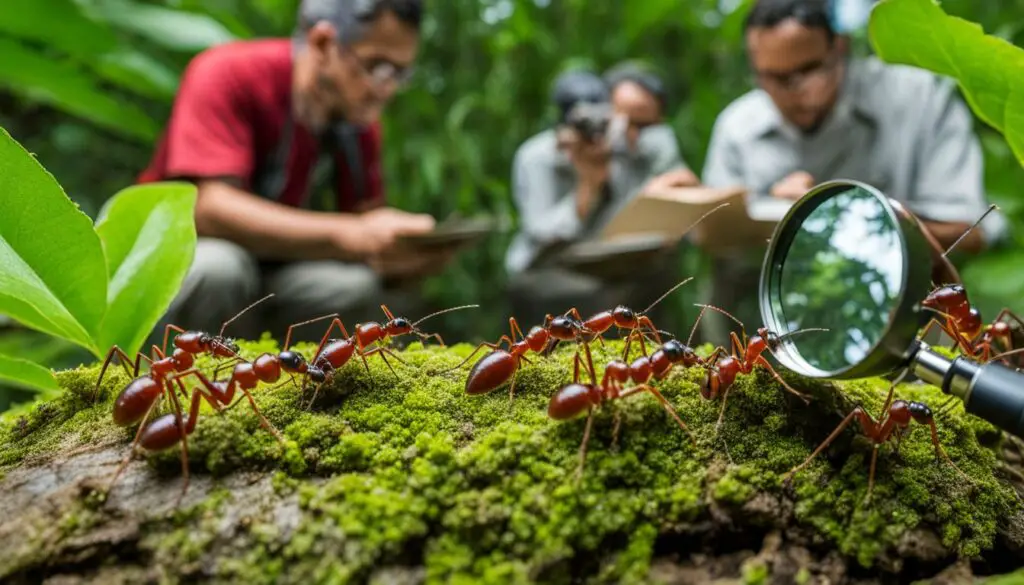
| Benefits of Harvester Ant Research | Conservation Measures for Harvester Ants |
|---|---|
| 1. Deepens understanding of their feeding habits and social behavior. | 1. Preserve and restore their natural habitats. |
| 2. Provides insights into their ecological impact and role in seed dispersal. | 2. Implement measures to prevent habitat loss. |
| 3. Helps manage their populations and protect their habitats. | 3. Raise awareness about the importance of harvester ants in ecosystems. |
Conclusion
In conclusion, the harvester ant is a fascinating species with unique feeding habits. These ants primarily feed on seeds, hoarding them in large quantities. However, they also consume other small insects and arthropods to supplement their diet. Understanding their food preferences and feeding behavior is important for their conservation and the preservation of their habitats.
The harvester ant’s diet reflects its role in seed dispersal and nutrient recycling within its ecosystem. By gathering and hoarding seeds, these ants contribute to the distribution of plants in their habitat. Additionally, their foraging patterns aid in the recycling of nutrients as they consume both plant matter and small insects.
Research and conservation efforts are crucial to protecting the harvester ant and its unique feeding habits. By studying their behavior, ecology, and conservation status, we can gain valuable knowledge and contribute to their long-term survival. It is important to prioritize their preservation and the preservation of their habitats to ensure the continued existence of these fascinating ants.
Overall, the harvester ant’s feeding habits and dietary preferences play a vital role in its ecological significance. By appreciating and understanding these aspects, we can better appreciate the important role these ants play within their ecosystems. Let us continue to protect and conserve this remarkable species and the intricate web of life they are a part of.
FAQ
Are harvester ants related to fire ants?
No, harvester ants, specifically the red harvester ant, are not related to fire ants.
How big are harvester ants?
Harvester ants have long bodies ranging from 1/4 to 1/2-inch in length.
What do harvester ants eat?
Harvester ants primarily eat seeds, but they may also consume other small insects, arthropods, and even feces of animals.
Where are harvester ants commonly found?
Harvester ants, specifically the red harvester ant, are common in the southwest United States.
Do harvester ants sting?
Yes, harvester ants have a powerful sting.
How do harvester ants forage for food?
Harvester ants have patrollers that locate food sources and leave chemical trails for the foragers to follow.
How do harvester ants identify their nests?
Harvester ants can be identified by their red, black, or brown color and the presence of psammaphore, a fringe of hairs lining the underside of the head.
What do harvester ant nests look like?
Harvester ant nests have distinct mounds surrounded by stripped vegetation and may have a single opening. Inside the nest, there are tunnels, chambers, and a sorting chamber.
What do harvester ants primarily feed on?
Harvester ants primarily feed on seeds, with a particular affinity for grass seeds like Needle Grama. They also consume seeds from other plants outside the grass family.
How do harvester ants reproduce?
Harvester ants mate through swarming, and the queen produces winged males and females called alates to start new colonies.
Do harvester ants infest homes?
Harvester ants typically do not infest homes but may be present in gardens or open areas.
Can harvester ants cause damage to the environment?
Harvester ants can have an impact on the environment due to their nesting habits, which can contribute to soil erosion. Their foraging patterns can also damage crops and cause road damage.
What should I do if I get stung by a harvester ant?
If stung, it is important to clean the area with soap and water, apply ice or a cold compress to reduce swelling, and take over-the-counter pain medication if necessary. Seek medical attention for severe cases or known allergies.
How long do harvester ant queens live?
Harvester ant queens can live for 15-20 years and continue to produce eggs throughout the colony’s life.
Can I keep harvester ants as pets?
Some individuals choose to keep harvester ants as pets, but it requires proper care and maintenance of the ant colony.
Why is research and conservation important for harvester ants?
Research and conservation efforts are important for understanding the behavior, ecology, and conservation status of harvester ants to ensure their continued survival.

